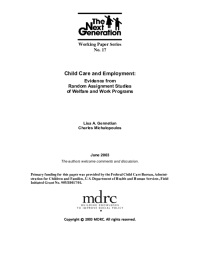Child Care and Employment
Evidence from Random Assignment Studies of Welfare and Work Programs
Summary of Key Findings for Working Paper No. 17
Background
Over the past decade, employment among single mothers rose dramatically, with most observers attributing a portion of that increase to welfare reform. Yet in the 1990s, federal and state governments changed not only welfare rules, but also policies related to child care, which is an important support of employment for low-income families. To what extent have child care policies encouraged or enabled single mothers to work, and conversely, to what extent has child care use increased as a result of increased employment that was induced by welfare reform? This paper exploits the random assignment design of 6 studies testing 19 welfare programs that began between 1993 and 1996 to examine the role of welfare, employment and child care policies on child care and employment decisions.
Key Findings
- Welfare reform programs that increased employment also increased use of nonmaternal child care, especially paid care.
- Despite the relationship between impacts on employment and use of paid care, impacts on employment were seldom matched by increases in use of child care subsidies, indicating that many newly employed families paid for care without receiving subsidies.
- Welfare reform programs had similar impacts on employment and on child care use for parents who reported child care barriers at the start of the studies and those who did not report such barriers.
- There is little evidence to suggest that the welfare programs with expanded child care assistance produced larger or more pronounced effects on employment, including more stable employment, as compared to the welfare programs that provided the same level of child care assistance to program and control group families.
Conclusions and Implications
These findings imply that many newly employed welfare and low-income families are not receiving child care subsidies. In some cases, this may be because of personal preferences that do not align with child care subsidy rules, but there might be other barriers that keep families from using subsidies, suggesting that there is still room for improvement despite the vast expansions in child care funding of the last decade. The findings also suggest that expanded child care policies did not dramatically affect the employment of welfare-reliant and low-income parents. However, because employment policies in these welfare programs were always combined with some child care assistance, further research is needed to ascertain the role of varying levels of child care assistance in encouraging employment.







